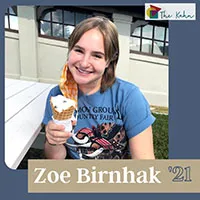Focus on Fellowship: Zoe Birnhak ’21
Published May 6, 2021
Discussing Inequity, Diversity, and Representation in STEM
By Sofia Trotta ’23
Zoe Birnhak ’21 recently participated in the Kahn short-term project The Notorious RCG: Race, Class, and Gender in STEM. She was one of two student fellows among some 25 faculty research fellows in the project, and discussed with the group her experience in STEM classes at Smith.

She recently answered questions about her experience in the Kahn project.
Khan: Why were you interested in participating in this project?
Zoe: I was interested in participating in this Kahn project because there is a real-world impact for student experiences in STEM. Since most STEM classes don't create a space to have conversations about inclusivity, projects like these are an important platform to have discussions about race, class, and gender. I used to be a neuroscience major but switched to sociology, and I believe there should be room to talk about greater social issues within the field. As a STEM student, I will eventually need to navigate these issues of race, class, and gender, so I think it's only natural to provide greater focus for these themes at the undergraduate level, in the courses STEM students already take.
Kahn: Can you describe the experience of participating in this project? What was it like for you to share in an intellectual exploration of this topic in a room of 25 faculty members?
Zoe: It was a little intimidating to be one of two students in a faculty group, but I felt heard by most of the faculty in my discussion groups. They were interested to know about what my experiences had been in my intro classes and how to reach students better, so I think the more students’ voices are centered in these projects, the better!
Kahn: What are your main takeaways from this project? What did you learn that will stay with you?
Zoe: I definitely learned a lot more about pedagogy and institutional barriers, though I believe with greater commitment and collaboration, these obstacles can be overcome. On the last day, we had the amazing opportunity to hear from faculty and student ambassadors from the HSTEM (Being Human in STEM) project at Amherst College, which was so enlightening! I learned a lot from their presentation, most importantly that interdisciplinary faculty and student collaboration is crucial to achieving goals of creating a greater future impact for those in STEM. I was excited to learn that the faculty at Smith want to teach more about systemic inequities and the complicated histories of STEM, but aren't sure where to start. HSTEM showed us that interdisciplinary collaboration can move initiatives like these forward with great strides.
Students should have more of a place in projects like these because student experiences are the cornerstone of pedagogical methods. It makes sense to have student and faculty collaboration as an active feedback response. I had a great time participating and am excited to see what happens next!